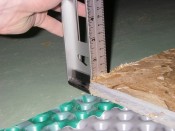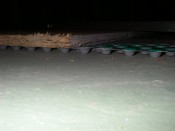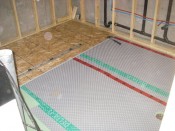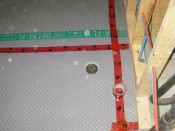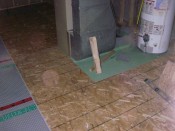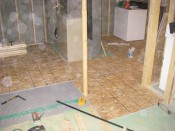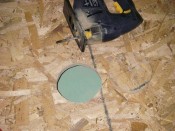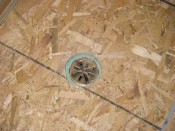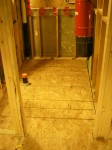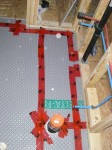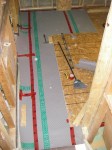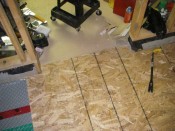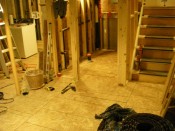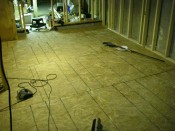Basement sub-floor
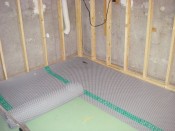 To do the basement sub-floor, I’m using a product called Delta-FL, which I picked up at Rona. It’s basically a big roll of dimpled plastic, which sits on top of the basement slab and acts as a vapour barrier, adds an air gap that helps insulate the floor, and also raises the floor up off the ground to avoid water damage in case there is a tiny amount of water. On top of this, I’m putting 5⁄8″ OSB, and then using tap-cons to secure the OSB to the floor. Although you can put some flooring (eg, laminate) directly on top of the Delta-FL, I was a bit worried about doing that since there are a couple places that aren’t totally level – the OSB lets me even them out and get very close to perfectly level.
To do the basement sub-floor, I’m using a product called Delta-FL, which I picked up at Rona. It’s basically a big roll of dimpled plastic, which sits on top of the basement slab and acts as a vapour barrier, adds an air gap that helps insulate the floor, and also raises the floor up off the ground to avoid water damage in case there is a tiny amount of water. On top of this, I’m putting 5⁄8″ OSB, and then using tap-cons to secure the OSB to the floor. Although you can put some flooring (eg, laminate) directly on top of the Delta-FL, I was a bit worried about doing that since there are a couple places that aren’t totally level – the OSB lets me even them out and get very close to perfectly level.
Once very nice thing about this flooring system is the minimal height it requires. Since my basement is a bit short (7′ 3″ unfinished floor to joists, 6′ 6″ unfinished floor to heating ducts), I wanted to keep as much of that as possible. The total height is just over 1″, so it really isn’t bad.
I have a 12″ piece of vapour barrier plastic underneath all the exterior framed walls. I called the manufacturer of Delta-FL to check what the best way of dealing with that was, and they advised me to tape the barrier directly to the Delta-FL, forming basically a complete seal around the walls. I used tuck tape to do this, and tape all the pieces together. I had to cut a couple holes out to fit the floor drain, toilet drain, and a jack post in the middle of the basement.
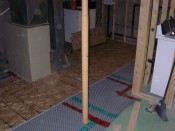 I worked in sections, putting a couple strips of Delta-FL down, and then laying the OSB on top of it, and connecting the grooves up. Once I had a couple pieces of OSB down, I would take some tap-cons and secure down the first row – I found it was much harder to get the tongue and groves of the OSB to connect up, if one of the pieces was already screwed down. I left 1⁄8″ gap between all the pieces of OSB, and the exterior framing. I was also careful to stagger all the sheets of OSB, so all of the ends are offset, forming stronger joints.
I worked in sections, putting a couple strips of Delta-FL down, and then laying the OSB on top of it, and connecting the grooves up. Once I had a couple pieces of OSB down, I would take some tap-cons and secure down the first row – I found it was much harder to get the tongue and groves of the OSB to connect up, if one of the pieces was already screwed down. I left 1⁄8″ gap between all the pieces of OSB, and the exterior framing. I was also careful to stagger all the sheets of OSB, so all of the ends are offset, forming stronger joints.
For the floor drain, I just made some careful measurements and then used my jigsaw to cut out a hole.
The toilet drain happened to line up with the edge of a piece of OSB, which made cutting the hole much easier. As you can see above, I also made sure the jack post was on an edge, so I only had to cut a U shape out of one piece – the other just butts up against the edge.
Though I don’t plan on doing anything with the crawlspace floor, I did put the sub-floor into the door opening, to make it easier to put the door on, as well as to hide the edge of the floor from the finished basement.
Today it is -10° Celsius out, and the surface temperature of the unfinished floor in the crawlspace is 9°, while the surface temperature of the OSB is 14°. The basement walls are still uninsulated, so this may not be overly conclusive, but it does show that it makes a difference.
Update: My girlfriend says “the basement floor feels much warmer now”. I guess that’s conclusive.
